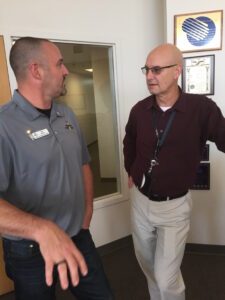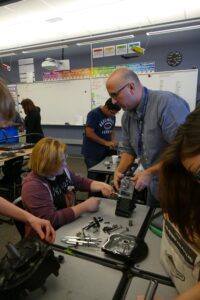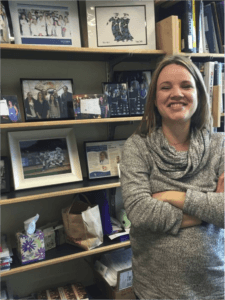Local STEM tour reveals engaged students, creative teachers and great potential careers
The magic of STEM (Science, Technology, Engineer and Math) and project-based learning were abundantly on display last week for a group of educators and civic leaders who took part in the Apple STEM Learning Tour.
The Apple STEM Network is building a grass-roots effort to support teachers learn how to effectively teach using STEM approaches and also helping students make the connection between and students and both higher education in STEM fields as well as STEM-related jobs in manufacturing, agriculture and virtually any other business.
The network is a collaboration of three school districts (Wenatchee, Eastmont and Cashmere), Wenatchee Valley College and the North Central Educational Service District, plus the Greater Wenatchee Area Technology Alliance and Chelan County Public Utility District.The implementation effort is co-chaired by Dr. Sue Kane of Wenatchee Valley College and Jenny Rojanasthien, the executive director of the GWATA.
A number of other businesses and organizations are supporting this effort. The network received an $111,000 grant that has been more than matched by local partners to implement the locally developed business plan.
I came away from the tour highly impressed with the level of engagement of students, the creativity and courage of teachers who were out of their comfort zone in teaching things like small engine repair, woodshop activities and robotics.
It was readily apparent that this kind of education could be transformational for students but at the same time create some challenges for our local teachers. That’s why the network business plan is emphasizing ways to support teachers as a key part of the initiative. It cannot be emphasized enough that this collaborative, cooperative locally-driven effort is likely to have much greater success than the top-down solutions with penalties for non-compliance than our friends in the Legislature impose on schools.
The tour was launched with a lunch gathering at the North Central Regional Library’s distribution center, where Luke Ellington, the assistant tech services and bookmobile manager, and tech director Chad Roseburg talked about the initiative to develop programs for the maker space tools that the library has acquired. “Maker spaces are becoming part of our main mission,” said Ellington. They’re experimenting with ways to deliver effective services to the kids who use the libraries throughout the system.
Our second stop was a mind-blowing, behind-the-scenes tour of Pacific Aerospace and Electronics, a tech company that has seen tremendous growth in the last few years. Ed Phinney, PA&E’s chief executive officer, showed us one kind of high-tech environment that is creating jobs for not only those with engineering degrees but also youngsters with aptitude coming out of high school and our community college.
The company has unique expertise in ultra-hermetic packaging applications that keep electronics operational in extreme conditions where failure can be fatal.
Sixty percent of PA&E’s sales are for military purposes, such as parts for the F35 Joint Strike Fighter and the Javelin anti-tank missile. Another 30 percent of sales are for medical devices such as heart parts and cochlear implants, Phinney said.
Sales have doubled from $20 million to $40 million in the last eighteen months, he said, and employment has increased from 165 to 270 in that period. PA&E has a STEM-rich environment and the culture is similar to what we saw in STEM efforts at local schools with a focus on teamwork, innovation and problem solving. There are great-paying jobs for talented people with STEM skills and the collaborative culture was a model for effective leadership.
At Orchard Middle School, our third stop, we saw innovative STEM efforts being developed under the guidance of Principal Taunya Brown. I have visited my share of middle school classrooms over the years and I don’t recall ever seeing students as energized as the students here and at Eastmont. One class, led by math teacher Darrell Moser, was taking apart small engines. Moser told us that he was learning along with the students.
Watching girls and boys figuring out how to take apart the engine parts had these students completely absorbed. Another class was doing woodshop projects, a third was creating a roller coaster out of paper and tape, and a fourth was doing tech work for teachers and administrators.
Our final stop was at Eastmont High School. Teacher Travis Kane of Sterling Middle School had some of his 36 students who stay after school to work on robotics show us what they are doing. We also saw the work of the high school robotics club and chatted with the students.
Expanding and growing the efforts in local schools is a key part of the Apple STEM Network initiative. Building our local resources and helping our kids connect with rewarding work that is otherwise going to be filled by people being recruited outside of area is a huge opportunity for us to build community.
Mark my words, folks. The Apple STEM Network is going to be a real game changer for this valley.

Wenatchee School District technology leader Ron Brown, left, with Ed Phinney, CEO of Pacific Aerospace and Electronics






